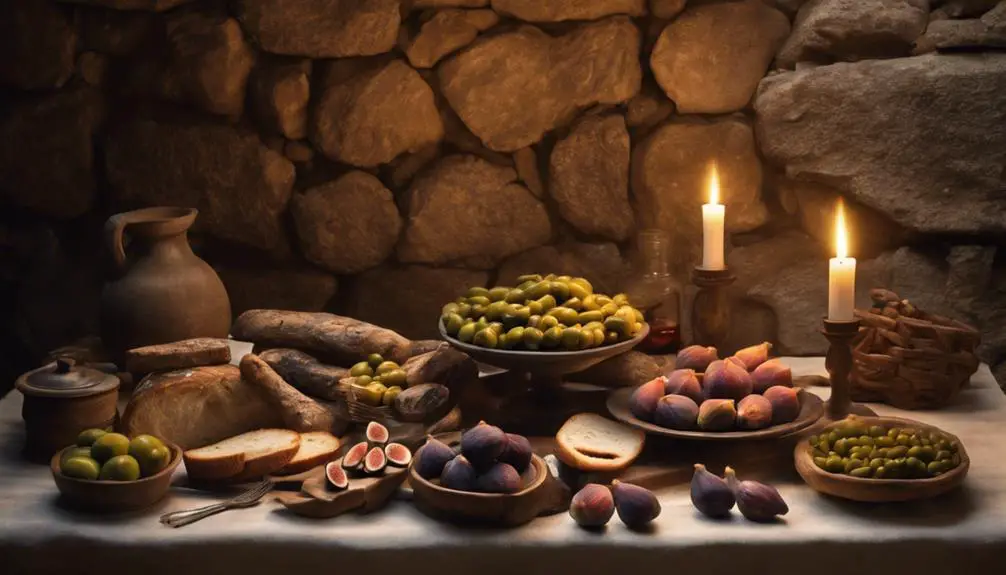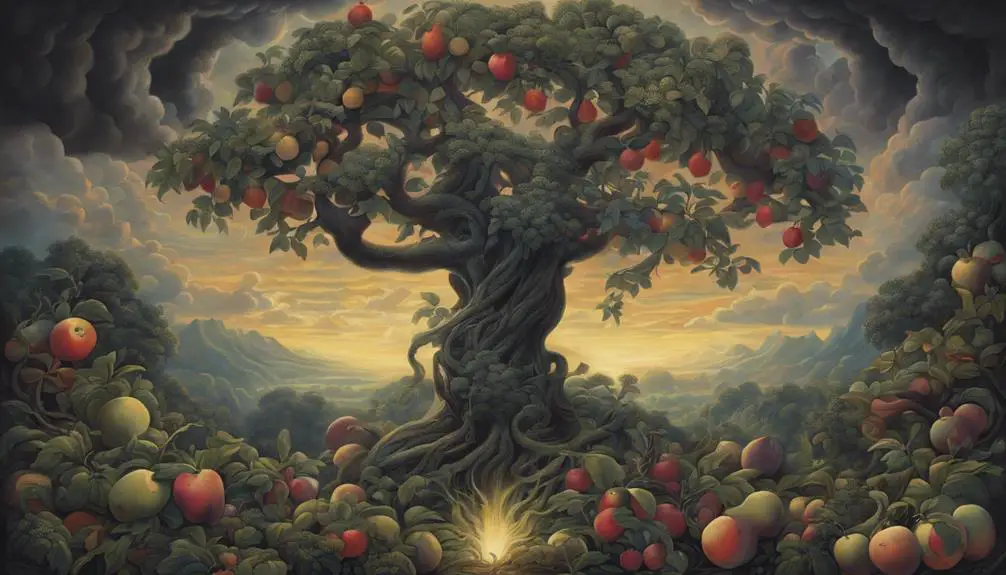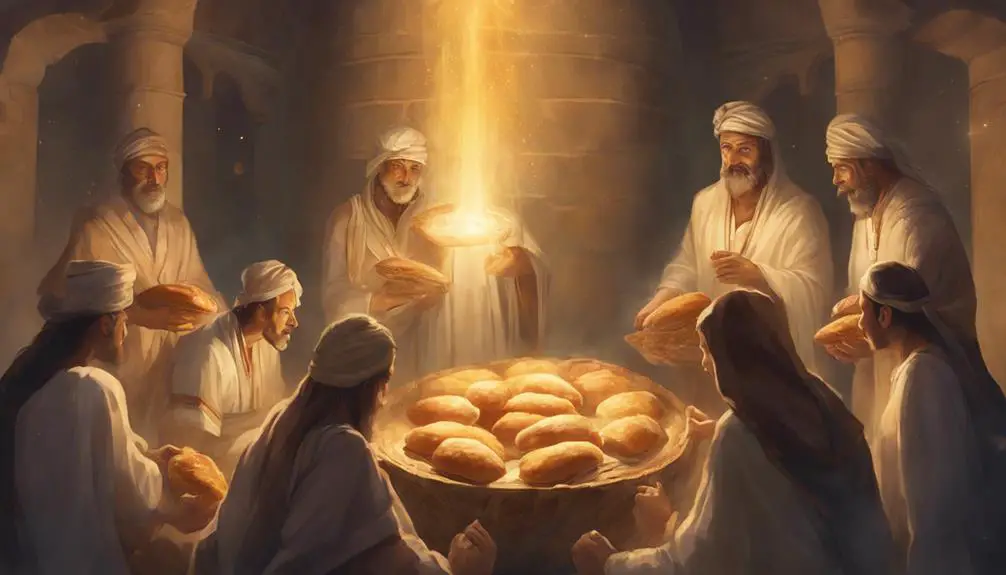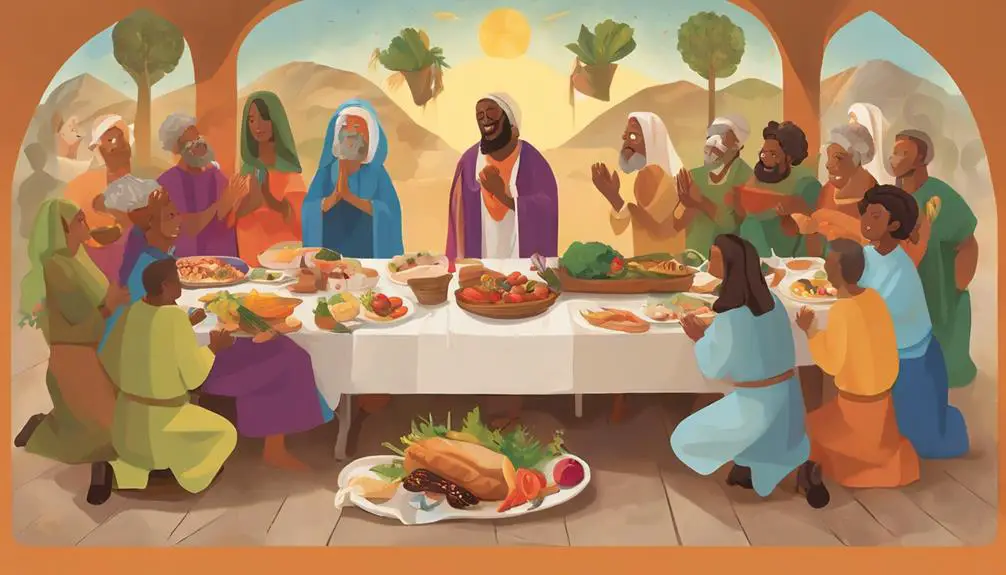Learn how meals in the Bible offer more than physical nourishment, hinting at spiritual truths and divine mysteries.

Victuals in the Bible
While the Bible opens with the forbidden fruit leading to mankind's fall, it closes with the promise of eternal sustenance in paradise.
You'll find that victuals in the scriptures are more than mere sustenance; they're laden with spiritual symbolism and divine promises.
From the manna that rained down from heaven to the loaves and fishes that fed thousands, each meal carries a deeper meaning.
As you explore the significance of bread, wine, feasts, and fasts, you'll uncover layers of meaning that might just transform your understanding of faith and sustenance.
What untold revelations lie in these holy meals?
Key Takeaways
- Biblical foods symbolize spiritual lessons, from sin and grace to trust and provision.
- Eating practices, including feasts and fasts, reflect deep religious meanings and community values.
- Miraculous food events challenge conventional views on resources and underscore divine generosity.
- Bread and wine hold profound significance in faith narratives, representing life, joy, and unity.
Forbidden Fruit and Sin

In analyzing the biblical narrative, it becomes evident that the consumption of the forbidden fruit symbolizes the inception of sin, profoundly altering humanity's relationship with the divine. This pivotal event, centered around Eve's temptation by the serpent, reveals the complexity of human nature and the profound consequences of disobedience. The serpent's deceit plays a crucial role in this narrative, illustrating the cunning ways in which temptation can lead to the downfall of even the most innocent of beings.
Eve's encounter with the serpent underscores the theme of temptation and the fallibility of mankind. The serpent's persuasive rhetoric convinces Eve to question God's command, highlighting the susceptibility of humans to doubt and deceit. The act of consuming the forbidden fruit, therefore, isn't merely a disobedience but a fundamental breach of trust between humanity and God, marking the beginning of sin and its pervasive influence on the human condition.
This narrative serves as a profound commentary on the nature of sin, temptation, and the consequences of turning away from divine commandments. Through the lens of Eve's temptation and the serpent's deceit, we gain insight into the origins of sin and its lasting impact on the relationship between humanity and the divine.
Manna: Heavenly Sustenance
While the narrative of the forbidden fruit highlights the emergence of sin through disobedience, the story of manna from heaven presents a contrasting theme of divine provision and grace. As you delve into this narrative, you're witnessing an extraordinary period of desert wanderings, where the Israelites' survival hangs in the balance. Yet, in their direst need, divine provision manifests as manna, a heavenly sustenance that not only feeds but also teaches profound lessons on dependence and faith.
- Dependence on Divine Provision: The daily appearance of manna underscores a life of reliance on God's provision, challenging the Israelites to trust beyond their abilities and resources.
- Grace and Provision: Manna, described as 'bread from heaven,' symbolizes grace, freely given to sustain life even in a barren desert, reminding us of the unmerited favor we receive.
- Test of Obedience and Faith: The specific instructions on gathering manna test the Israelites' obedience and faith, mirroring the broader journey of spiritual growth and dependence on divine guidance.
Manna's narrative, rich in symbolism, offers a multifaceted look at how divine provision and grace are central to the journey of faith, especially during times of trial and uncertainty in the desert wanderings.
Loaves, Fishes, and Miracles

Transitioning from the divine sustenance of manna, we now explore the miracles of loaves and fishes, where multiplication feeds multitudes and underscores a profound theological truth about provision and abundance. You'll find these narratives not only highlight the miraculous but also delve into the ethics of multiplication and the imperative of community sharing. These stories serve as pivotal moments, illustrating how scarcity is confronted with divine abundance, thereby challenging our understanding of resources and generosity.
Analyzing the loaves and fishes miracles, you're invited to consider the symbolism behind the act of breaking bread and distributing fish. This isn't merely about feeding a physical hunger but also addresses a spiritual hunger for community and shared experiences. The act of multiplying the loaves and fishes underscores a critical lesson in trust and the power of collective action underpinned by faith. It's a demonstration of how, when resources are shared, not only is there enough, but the abundance overflows.
These miracles, therefore, aren't just ancient stories but are imbued with lessons on multiplication ethics and community sharing that resonate profoundly in today's context. They beckon you to reflect on how resources are utilized and distributed, advocating for a model of generosity and trust in divine provision.
Bread and Wine Significance
Shifting focus, we now examine the profound symbolism of bread and wine, essential elements that not only sustain life but also carry deep theological significance within the biblical narrative. These elements aren't just food and drink; they embody rich layers of meaning, encapsulating the essence of communion symbolism and cultural rituals across diverse communities.
- Bread as a Symbol of Life and Nourishment: In biblical texts, bread frequently represents life and sustenance, mirroring the spiritual nourishment God provides to His followers. It's a staple of existence, both physically and spiritually, reinforcing the idea that just as one needs bread to live, so too does one need spiritual sustenance from God.
- Wine as a Symbol of Joy and Covenant: Wine, with its rich tapestry of taste and its role in celebrations, symbolizes joy, festivity, and the blood of the covenant. It marks significant moments and covenants between God and humanity, illustrating the depth of relationship and commitment.
- Communion and Unity: The act of sharing bread and wine in religious ceremonies underscores the unity and communal relationship among believers. It's a tangible expression of faith and collective identity, transcending individual differences and fostering a sense of belonging.
These symbols are deeply ingrained in cultural rituals, illustrating how everyday elements can hold extraordinary significance in the context of faith and community.
Feasts and Fasts

In the biblical context, feasts and fasts serve as pivotal rituals that embody spiritual reflection, community bonding, and divine worship. The significance of these practices cannot be overstated, as they're deeply woven into the fabric of biblical history and theology. Let's delve into the nuanced roles these rituals play.
Feasts and Fasts |
Significance |
|---|---|
Passover |
Commemorates the Israelites' liberation from Egyptian slavery, emphasizing God's deliverance and the importance of remembrance. |
Day of Atonement |
A solemn fast, highlighting repentance, forgiveness, and the human-divine relationship. |
Feast of Booths |
Celebrates the harvest and recalls the Israelites' wilderness wanderings, reinforcing reliance on God. |
Prophetic Diets |
Symbolize obedience, purity, and often, a forewarning or a call to repentance (e.g., Daniel's refusal of royal food). |
Fasting Rituals |
Encourage humility, self-discipline, and spiritual clarity, often associated with seeking God's guidance or intervention. |
The Passover significance and prophetic diets particularly stand out as they encapsulate key theological themes: liberation, covenant, and a call to holiness. Through these observances, you're invited into a deeper understanding of faith, where food becomes more than sustenance—it's a means of grace, a symbol of salvation, and a medium for divine encounter.
Frequently Asked Questions
How Did Dietary Laws Affect Daily Eating Habits in Biblical Times?
Dietary laws significantly shaped daily eating habits in ancient times. You'd notice that health implications were a primary concern, leading to specific culinary techniques to ensure food safety. These laws dictated what could be eaten, how it was prepared, and when.
They influenced not just individual choices but the overall community's dietary practices. By adhering to these guidelines, people aimed to maintain purity, health, and social cohesion within their communities.
Were There Any Specific Foods Mentioned in the Bible That Are Still Consumed Today?
Absolutely, several foods mentioned in ancient texts are still enjoyed today, creating fascinating modern parallels. For instance, olives, figs, and bread, deeply rooted in food symbolism, continue to hold significant cultural and nutritional value.
Analyzing these enduring staples offers insights into historical dietary practices and their lasting impact. It's intriguing to see how these ancient foods have seamlessly woven themselves into contemporary diets, bridging millennia through shared culinary heritage.
How Did the Concept of Hospitality and Sharing Meals Influence Community Life in Biblical Narratives?
Imagine a table where every seat's filled, a symbol of unity. In biblical narratives, communal feasts weren't just about eating; they were a cornerstone of society.
These gatherings, deep-rooted in eating ethics, fostered a sense of belonging and reinforced moral and social codes within communities. Sharing meals wasn't merely a physical act but a profound expression of hospitality that knitted individuals into a cohesive, supportive network, shaping community life fundamentally.
Can We Find Any References or Implications About Vegetarianism or Meat Consumption in the Bible Outside of the Provided Sections?
Yes, you can find references to both vegetarianism and meat consumption throughout the Bible, beyond the specified sections. These texts often tie into practices like animal sacrifices and fasting rituals, reflecting broader themes of purity, devotion, and community values.
For instance, animal sacrifices were integral to Old Testament worship, symbolizing atonement, while fasting rituals could include abstaining from meat, hinting at periods of purification or penance.
How Did Agricultural Practices and Seasonal Changes Influence the Diet and Religious Observances in Biblical Times?
In biblical times, agricultural practices and seasonal changes were pivotal, shaping daily sustenance and religious observances. Climate impact dictated when and what could grow, leading to harvest festivals celebrating these cyclical bounties.
This interplay wasn't just about survival; it was deeply symbolic, reflecting gratitude and dependence on divine provision. Understanding this context offers a rich, analytical insight into how faith intertwined with the rhythms of nature.
Conclusion
In the Bible, victuals transcend mere sustenance, embodying profound theological and moral narratives. The forbidden fruit marks humanity's fall, while manna epitomizes divine provision. Loaves and fishes illustrate Christ's miraculous abundance, paralleled by the symbolic bread and wine, signifying sacrifice and covenant.
Feasts and fasts further delineate a spiritual rhythm, contrasting times of communal celebration with personal reflection and atonement. Collectively, these elements weave a rich tapestry, reflecting the intricate interplay between the divine and the mundane, the sacred and the profane.



Sign up